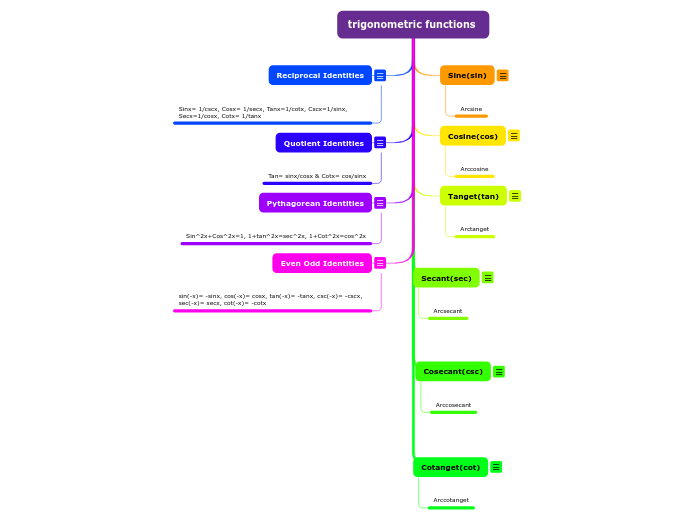
Domain: all real numbersRange: [-1 , 1]Period = 2pix intercepts: x = k pi , where k is an integer.y intercepts: y = 0maximum points: (pi/2 + 2 k pi , 1) , where k is an integer.minimum points: (3pi/2 + 2 k pi , -1) , where k is an integer.symmetry: since sin(-x) = - sin (x) then sin (x) is an odd function and its graph is symmetric with respect to the origin (0 , 0).intervals of increase/decrease: over one period and from 0 to 2pi, sin (x) is increasing on the intervals (0 , pi/2) and (3pi/2 , 2pi), and decreasing on the interval (pi/2 , 3pi/2).
Arcsine
Domain: all real numbersRange: [-1 , 1]Period = 2pix intercepts: x = pi/2 + k pi , where k is an integer.y intercepts: y = 1maximum points: (2 k pi , 1) , where k is an integer.minimum points: (pi + 2 k pi , -1) , where k is an integer.symmetry: since cos(-x) = cos (x) then cos (x) is an even function and its graph is symmetric with respect to the y axis.intervals of increase/decrease: over one period and from 0 to 2pi, cos (x) is decreasing on (0 , pi) increasing on (pi , 2pi).
Arccosine
Domain: all real numbers except pi/2 + k pi, k is an integer.Range: all real numbersPeriod = pix intercepts: x = k pi , where k is an integer.y intercepts: y = 0symmetry: since tan(-x) = - tan(x) then tan (x) is an odd function and its graph is symmetric with respect the origin.intervals of increase/decrease: over one period and from -pi/2 to pi/2, tan (x) is increasing.Vertical asymptotes: x = pi/2 + k pi, where k is an integer.
Arctanget
Domain: all real numbers except pi/2 + k pi, n is an integer.Range: (-infinity , -1] U [1 , +infinity)Period = 2 piy intercepts: y = 1symmetry: since sec(-x) = sec (x) then sec (x) is an even function and its graph is symmetric with respect to the y axis.intervals of increase/decrease: over one period and from 0 to 2 pi, sec (x) is increasing on (0 , pi/2) U (pi/2 , pi) and decreasing on (pi , 3pi/2) U (3pi/2 , 2pi).Vertical asymptotes: x = pi/2 + k pi, where k is an integer.
Arcsecant
Domain: all real numbers except k pi, k is an integer.Range: (-infinity , -1] U [1 , +infinity)Period = 2pisymmetry: since csc(-x) = - csc(x) then csc (x) is an odd function and its graph is symmetric with respect the origin.intervals of increase/decrease: over one period and from 0 to 2pi, csc (x) is decreasing on (0 , pi/2) U (3pi/2 , 2pi) and increasing on (pi/2 , pi) U (pi / , 3pi/2).Vertical asymptotes: x = k pi, where k is an integer.
Arccosecant
Domain: all real numbers except k pi, k is an integer.Range: all real numbersPeriod = pix intercepts: x = pi /2 + k pi , where k is an integer.symmetry: since cot(-x) = - cot(x) then cot (x) is an odd function and its graph is symmetric with respect the origin.intervals of increase/decrease: over one period and from 0 to pi, cot (x) is decreasing.Vertical asymptotes: x = k pi, where k is an integer.
Arccotanget
They are typically used for solving triangles that are missing the hypotenuse, and when you need to use tangent, but missing the adjacent side.
Sinx= 1/cscx, Cosx= 1/secx, Tanx=1/cotx, Cscx=1/sinx, Secx=1/cosx, Cotx= 1/tanx
These identities help solve the two important parts in a trig function.
Tan= sinx/cosx & Cotx= cos/sinx
These identities are used in architecture all the time to help find the shape and angle of the building.
Sin^2x+Cos^2x=1, 1+tan^2x=sec^2x, 1+Cot^2x=cos^2x
These identities are used to help find the negatives of each trig function.
sin(-x)= -sinx, cos(-x)= cosx, tan(-x)= -tanx, csc(-x)= -cscx, sec(-x)= secx, cot(-x)= -cotx